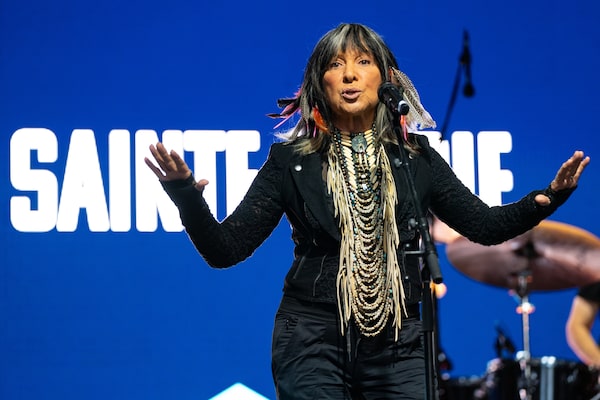
Buffy Sainte-Marie performs at the Toronto International Film Festival's kickoff event in Toronto on Sept. 8, 2022. CBC says the legendary musician's birth certificate, other documents and details from family members contradict the singer's claim that she is Indigenous.Alex Lupul/The Canadian Press
These are difficult, spiritually testing times in the Indigenous community. An icon of mythic proportions is being questioned. Her origins under suspicion. Is who she is who she claims? For almost 60 years, Buffy Sainte-Marie has been at the forefront of an epic Indigenous cultural and artistic revival. In some ways, she literally is a saint to many.
Her status in the First Nations community is unparalleled. She is essentially a one-name phenomenon, akin to Madonna, Cher, Elvis etc. Across what is called Turtle Island, the Indigenous community is holding its collective breath as to how her journey will end.
Is Buffy Sainte-Marie a pretendian? It’s a difficult question that The Fifth Estate is tackling, in a lengthy investigation published online on Friday, and in an episode on Friday night. The instalment just might be the most watched episode of the series in many years. So many in our community will be watching. Some seeking knowledge. Others looking to cast doubt. Others merely wanting to know what the hell is going on.
I’ve seen Sainte-Marie perform four times, each event more amazing than the time before. And I’m fairly sure I have personally contributed to the maintenance of her ranch in Hawaii through the numbers of albums and CDs I’ve purchased over the years. I was and still am a member of the loyal and concerned throngs.
That’s why the complexity of the issue is mind-boggling. The dominant culture may not understand this.
An important part of the discussion is: Who is Indigenous and who isn’t, and who can make that assessment? There are few things more personal to a person and a people than their identity and culture. Many say identity is a community issue. Who has more authority to best judge who is in our family and who isn’t? The Piapot family has taken great pains to point out they adopted Sainte-Marie back in the early 1960s. Because of that, she is a treasured and loved member of the family. Nobody is arguing that, I believe. In the First Nations community, family is family is family.
Buffy Sainte-Marie addresses questions about her Indigenous ancestry: ‘I know who I am’
(However, I remember Joseph Boyden was adopted by two, possibly three Cree families at the time of his controversy, and it didn’t seem to matter to the community at large. As of this writing, he is still wandering the barren lands in search of acceptance.)
Others believe identity should include documentation. The more the better. A paper trail per se: birth certificates, adoption papers, status cards, etc. All things the dominant culture holds true and honest. Others believe such documentation is suspect. They’re merely manifestations of colonization which are to be feared and considered suspicious. Yet the Cherokee in the United States have some of the most well-documented citizen lists in North America. You cannot call yourself a Cherokee without your ancestry being listed, annotated and filed.
Coincidentally, somebody a few days ago made a comment to me about Mary Ellen Turpel-Lafond. Specifically, my friend was concerned about how much good work she did for Indigenous people over the years in her capacity as a lawyer and a judge. What a shame all that positivity is being overlooked after the revelation her jingle dress doesn’t have any real jingles. But unfortunately, Indigeneity can’t be earned.
On Twitter/X, many have argued that Sainte-Marie is in her eighties, a respected and honoured elder whose work for the Indigenous people of Turtle Island cannot be forgotten. It would take at least a dozen or more brilliant Indigenous artists combined to make it halfway up Mt. Buffy. So, they argue, the good people of CBC should let it and her pass. The world is a much better place with Buffy in it.
Others argue pretendians are “trying to erase us by replacing us.”
As I mentioned, this is all so complex.
To understand the true scope of Buffy’s Indigenous appeal, I remember reading about an encounter with her in David Suzuki’s autobiography. Back in another century, he was putting together a massive concert to promote the old-growth forest in British Columbia’s Stein Valley. All types of musical celebrities were there including Buffy Sainte-Marie. He writes about the how the audience, a substantial amount who were Indigenous, just went crazy when she took stage. It was then he understood the impact this woman had upon the people of the land. They were enthralled. There was no other word for it other than a complete and shared love.
As with all stories, there are many other people being affected by the debate, including Buffy’s birth family in America. This is their story, too. Their opinion is just as valid as the Piapots’. They maintain Buffy Sainte-Marie nee Beverly Santamaria has been denying the heritage she was born with. Where her Indigenous identity came from, they don’t know. And it hurts them.
There are stories. There are documents. Much like God and the Prime Minister, it is up to every interested individual to make up their mind about what they believe.
Regardless of what comes from the Fifth Estate episode, I am fairly sure the sun will rise tomorrow. Dogs will bark. Children will want breakfast. Bannock will be cooked … though it may not seem a golden or as tasty as the morning before. And dreamcatchers hanging in windows may not have had as many good dreams pass through them.
But I can practically guarantee out there in Indigenous communities, Starwalker or Bury My Heart At Wounded Knee will be playing somewhere.